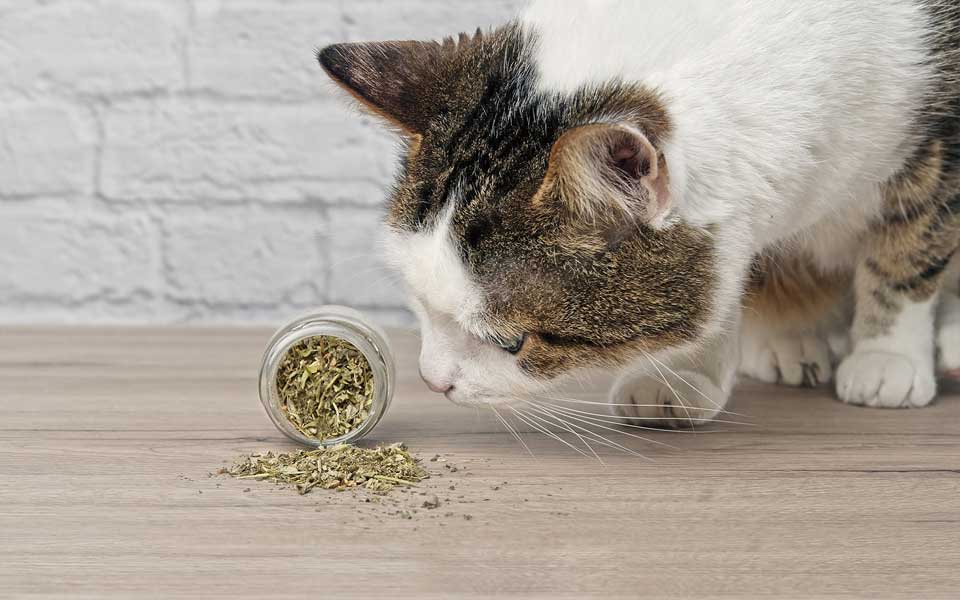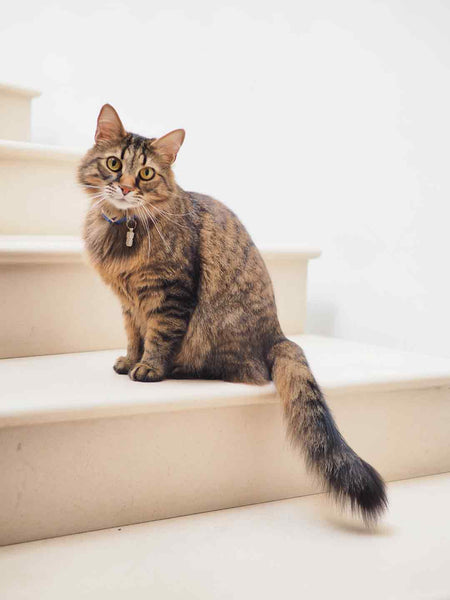
What Does Catnip Do to Cats?
Many kitty parents are familiar with the strange and unique behavior that happens when a cat encounters catnip.
The mewling, body contortions, manic darting from one place to another, and general craziness that ensues when kitties come in contact with this herb are hilarious to watch.
But how and why does it cause this effect in cats?
In this article, we’ll talk about what catnip is, where it comes from, and the science behind how it causes this ""kitty high"" effect.
What is Catnip Really?
Catnip, known scientifically as Nepeta cataria, is actually a member of the mint family of herbs. Besides mint itself, this also includes kitchen favorites like rosemary, sage, and basil. This is also where catnip gets its alternate name, ""catmint"" from.
The main ingredient in catnip that causes its effects in cats is called nepetalactone, which is produced primarily in the leaves and stem of the plant. The plant’s production of this essential oil component is unique among members of the mint family.
Interestingly enough, nepetalactone doesn’t just function as a mood-altering substance in cats. According to an article from this year in Science Advances, nepetalactone likely evolved in catnip as a natural insect repellent. And indeed, studies have shown that it has repellent ability comparable to DEET.
Where Did Catnip Come From?
Catnip isn’t native to North America. It was brought over by settlers from Europe, Asia, and Africa for some of the health benefits seen in people. While people aren't affected by catnip the way cats are, in the olden days, it was often utilized as a mild sedative and as a tonic for colicy babies.
The history of catnip isn’t entirely clear, but may have its origins dating back to ancient times. Given their high regard of felines, it’s reasonable to assume that the ancient Egyptians may have been the first to discover catnip’s effect on cats.
It’s widely known that the Romans used the herb themselves for its health properties and in fact the latin name Nepeta may have been derived from the ancient Etruscan city of Neptic which was located only about an hour north of present-day Rome.
The name ""catmint"" isn’t seen historically until the Middle Ages, at which time it was also referred to as ""nep"". It remained an herbal staple for people well after settlers flocked to North America in the 18th century, until its uses were replaced by more modern therapies and medications.
Why Do Cats Like Catnip?
The basic principle of how catnip works is pretty simple. Nepetalactone is a versatile essential oil. In addition to being a potent herbal insect repellent, it also doubles as a pheromone mimic in cats.
To understand how nepetalactone functions like a pheromone, it’s first important to understand how pheromones work.
Pheromones are chemical substances that can act like hormones. But hormones, like testosterone, estrogen, and others, are all produced within the body, to produce effects on the body itself. Pheromones are created externally by plants or animals to impart an effect on other members of the same species, not on themselves.
Now, notice I mentioned that nepetalactone is a pheromone mimic. It’s not a true pheromone in cats because it’s not produced by cats for other cats. It’s produced by a plant which has an indirect effect on cats, but one that has a pretty significant, pheromone-like effect.
Cats have a specialized organ called a vomeronasal organ, also known as Jacobson’s organ that can receive chemical signals and send them on to the brain for interpretation. Actually, many animals have this organ, not just cats, but the ability to utilize it can differ among animal species.
Located between the roof of the mouth and the nasal passages, this organ is used often by cats. Ever seen your kitty appearing to sniff something with his mouth open? This is called the Flehmen response and is the act of him using his vomeronasal organ to pick up and interpret a chemical signal. Mostly, our felines use it to pick up chemical scents left by other cats in urine, especially female cats in heat.
Cats are attracted to the chemical scent of nepetalactone, which is pulled into the vomeronasal organ where they analyze it just like a pheromone.
Now, while this part of how catnip works is pretty clear, the rest is about as fuzzy as your purring pal’s mind likely gets when he comes in contact with it.
Nepetalactone, acting like a pheromone, clearly causes a chemical response, but it’s not a narcotic. Research has shown that there are likely other compounds in catnip that bind to neurotransmitters in our kitties’ brains, directly leading to lowered inhibitions and some pretty crazy behavior.
It’s not 100% clear exactly how catnip affects a cat’s brain, but researchers do suspect that opioid receptors may be involved somehow. Opioid receptors are what allow our bodies to respond to pain-relieving drugs like morphine, which can also create a sense of euphoria.
While there isn’t direct evidence that this takes place, there is some indirect evidence. When given naloxone, a drug which reverses the effects of substances that bind to opioid receptors (essentially a ""reversal"" agent for drugs like morphine) researchers have found that cats exhibit a lower response to catnip.
What Does Catnip Do to Cats?
Although catnip is a stereotypical item that goes along with cats just like bones go with dogs, not all cats appear to be affected by it.
While study results differ, most suggest that only about ½ -⅔ of cats are actively affected by it as based on that crazy, hyper excited, euphoric behavior we all think of. This is thought to be due to some cats being genetically more prone to catnip response, while others simply don’t have it in their DNA.
Even wild cats and the big cats can show a response to catnip, especially lions and jaguars. Tigers appear to have less affinity for it, possibly supporting that genetic predisposition for some cats, while others show little to no response.
It’s also commonly accepted that cats can’t be affected by catnip until a certain age with most agreeing that until a few months of age, kittens aren’t subject to getting the crazies on catnip.
But there might be some newer information that suggests differently. When we think of how cats typically respond to catnip, we think of that crazy, erratic, euphoric behavior.
But according to a 2017 study published in Behavioural Processes, cats can show a more passive response too. This passive response was described as the ""sphinx position"" coupled with decreased vocalizations and decreased motor activity. Basically, these cats just sit down and mellow out.
Interestingly, when looking for this passive response in addition to the crazy behavior we normally think of, these researchers appreciated 100% of cats responding to catnip, including very young kittens, juveniles, adults, spayed or neutered cats, and sexually intact cats.
According to this study, about 20% of cats showed an active response, but 80% showed this more passive, mellow response.

Some Test Subjects: My Own Kitties
I’ve used catnip from time to time in toys for my own cats, Teach, Bart, and Annie, who are all littermates, about 12 years old now. For this article, I decided to see how each of them individually responded to about 2 teaspoonfuls of dried catnip inserted into a small stuffed mouse toy. I smushed the catnip with my fingers and left the velcro pouch open, so they could really get a good whiff of it.
Both Teach and Annie showed some mild interest, sniffing the open pouch and rubbing their heads on it, but honestly showed more interest in rubbing on me and looking for some pets, which I can’t complain about.
But Bart was a different story. He got a whiff of the catnip and tried very hard to stuff his whole face into the small velcro pouch. He then proceeded to roll around with the toy, chewing and licking at it for about 10 minutes before apparently losing interest.
You can see from the photos below the feline blur he became in the throes of his catnip high, rolling around with the toy. This was followed by his ""mischief managed"" look complete with catnip bits all over his face.
Did Teach and Annie have a more ""passive"" response? Hard to say really, and at times I’ve seen Annie show more interest, but for today’s experiment, that’s 1 out of 3 cats responding. Would freshly-grown catnip have shown a better response? Quite possibly, as this has been suggested. But another experiment for another time.
Bart’s response is the pretty stereotypical one we normally expect. The effect of catnip on a highly responsive cat seems to last for only about 10 minutes and it can take a couple of hours before he’ll be interested in it again.
Give a cat catnip too often, and we might see it lose its effect on a particular kitty after some time.
Can Cats Eat Catnip?
For the most part, cats don’t seem to have a big desire to ingest catnip, even my Annie who loves hunting the house for dried leaves we’ve tracked indoors by accident.
But in the course of play with a catnip-filled toy, it’s inevitable that a frolicking feline might ingest some. Usually, this is not a significant problem.
While some sources do list catnip as ""toxic"" to cats, including the ASPCA Poison Control site, ""toxic"" in this case does not refer to making a cat dangerously ill. Just about anything, if ingested in large enough amounts, can cause toxicity signs.
Catnip can cause mild self-limiting vomiting or diarrhea, but only if large amounts are ingested. Fortunately, and fingers-crossed, I have yet to get a call from a concerned kitty parent about catnip ingestion.
But what about cat grass? Lots of folks provide fresh cat grass for their kitties. Is it at all related to catnip?
Cat grass is a completely separate collection of plants. Cat grass is actual grass, usually of the rye, oat, wheat, or barley grass variety, and is not related to the mint family at all.
Cat grass contains folic acid, an essential B vitamin, and can act as a laxative, aiding in digestion and passage of hair, so it can be a healthy item to provide.
It’s true that some cats will vomit after eating cat grass, but there is a theory that even wild cats will ingest grass as a means of bringing up indigestible components of their last meal, so this might be a healthy response as long as it doesn’t happen all the time.
Regardless of why cat grass is so interesting to kitties, it’s probably something more instinctually a part of their nature, and is not related to the ""altered reality"" effect caused by catnip.
The Good, the Bad and Growing Your Own
Catnip can be considered a valuable part of environmental enrichment, especially for indoor-only cats.
While it clearly does cause an altered mental state in cats that respond very highly to it (and possibly even the ones that show that more ""passive"" response). This effect is very short-lived and cats cannot become addicted to it. As mentioned, increased frequent exposure to it generally leads to a loss of response, that’s why it’s best not to provide it more often than every 2 weeks or so.
But even though catnip is safe and generally harmless, there are some precautions. Avoid catnip use if you’ve ever noticed your cat develop signs of agitation or aggression when exposed to it. It should also be avoided in pregnant queens, and any cats with a history of neurologic signs or seizures.
Frequent exposure can render a cat’s response moot. So while cat grass is a nice indoor item to have available for your furry friend to graze on, it’s probably best to keep catnip cultivation to the outdoors, if you choose to grow it yourself.
Although it is technically only native to Europe, Africa, and Asia, catnip can grow very easily in North America, just like other members of the mint family. It’s a perennial that comes back year after year with an attractive purplish blue flower that makes it a nice ornamental for the garden.
So whether you decide to grow it fresh or purchase the dried crushed form from the pet store, catnip can be a healthy and harmless way to provide your kitty with 10-15 minutes of special enjoyment. Add it into the recommended ""fifteen minutes of play a day"" regimen for your kitty once every couple of weeks. It can also provide 10-15 minutes of hilarious entertainment for you to share with your special furry friend.








